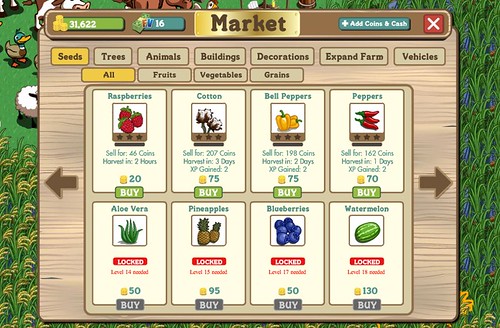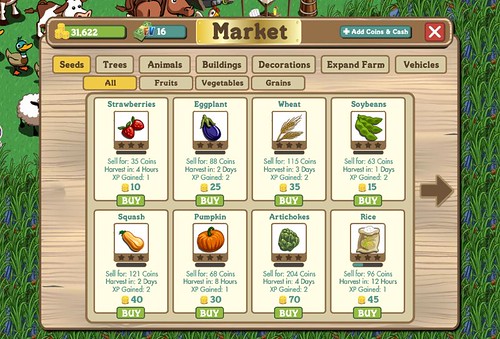Profits! Profitability! The holy grail of business. Yet surprisingly, one of the most difficult things to calculate. Companies spend thousands of dollars a year in consulting, technology, software, systems, and accounting firms just to get a vague idea of their profitability. Why?
Here’s an example of how difficult profitability can be even in a very closed, contained, predictable system. Let’s take Farmville, the popular Facebook game. Of all the crops available to early players of the game, which is the most profitable?
A casual look says it should be cotton. That giant 207 coin payout for planting cotton is definitely the biggest number on the page. Of course, that’s only gross profit. Each crop also costs money to plant. Do some quick math to subtract the cost of seeds and suddenly artichokes become more profitable – that’s net profit per crop, profit after costs.
So, should you go plant artichokes willy-nilly? Not necessarily! You forgot tilling costs, which is a fixed, flat 15 coin fee for every plot of land. While this may not change the choices between artichokes and cotton, it drastically alters the profitability of cheaper items like soybeans, which at first glance look like a terrific investment – plant for 15 coins to reap 63 – but becomes plant for 30 coins to reap 63 after the tilling cost.
Finally, take the amount of time you’re willing to invest in Farmville. For me, it’s virtually none. I’ve got better games to play in my free time, like Warcraft, so Farmville is at best a curiosity. If you’ve got a lot of time to invest in the game, then you have to do one final calculation for profitability – how much income per hour each crop reaps. Divide each crop’s net profit after costs and tilling by the number of hours to maturity to get net profit per hour, and suddenly, inexpensive but time intensive raspberries yield the highest overall profit per hour – if you’re willing to babysit them every two hours.
What’s the lesson in all of this? Calculating return on investment and profitability can be very tricky. In the incredibly simple Farmville case, the tilling cost is one people leave out of their calculations more often than not. The example of raspberries also demonstrates that what looks like the biggest number at first (artichokes) isn’t – you might be better served cranking out a smaller margin with high frequency than a big margin very infrequently, particularly if you’re in a business where market conditions shift rapidly.
Now imagine how difficult this is to apply to real businesses, where prices, markets, and conditions change, where costs and profits are not fixed, and where time is not free, and you get a sense of how truly amorphous profitability can be.
This is also why it’s super important to get kids and adults playing games like Farmville and Warcraft, to teach them the powerful economics lessons in their games so that they can dig into understanding business without putting real money on the line.
Have fun farming!
Did you enjoy this blog post? If so, please subscribe right now!
Enjoyed it? Please share it!
Get this and other great articles from the source at www.ChristopherSPenn.com





Leave a Reply